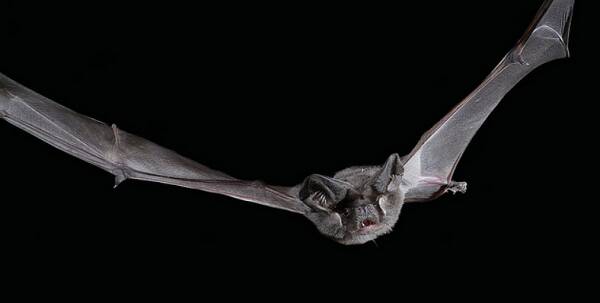,European free-tailed bat
IUCN
LCBasic Information
Scientific classification
- name:,European free-tailed bat
- Scientific Name:,European free-tailed bat
- Outline:Chiroptera
- Family:Pterodactyla Cyrtopteridae Cyrtopterus
Vital signs
- length:80-94mm
- Weight:
- lifetime:
Feature
The ears are large, short and broad, and have a distinct sharp Angle, and the body is covered with dark brown short hair, and the wings are also dark brown.
Distribution and Habitat
It is distributed in Yunnan, Sichuan, Fujian, Anhui, Guangxi, Taiwan, Guizhou, Hubei, Shandong and Guangdong. It is distributed abroad in Japan and Korea.
It lives in mountain caves and crevices below 3,100 m above sea level, choosing depressed rock crevices, open quarries, cliffs or Bridges and buildings as habitat sites in summer, and hibernating in caves in winter.
Appearance
Big and strong. Body length 80-94mm. Tail length 47-60mm. Forearm length 57-66mm. The legs are short but the feet are large, the hind feet are more than half the length of the tibia, and the middle plantar has a visible pad, and the toes have curved hairs. The wings are long and narrow, and the membranes are thick and leathery. The ears are large, semicircular, with 9-10 transverse lines in the ear mask. The anterior base of the ears is connected at the forehead. The leading edge of the ears is slightly flat, and the middle of the posterior margin is marked with a significant dent. The upper lip is hypertrophic and the nose is prominent. The snout is covered with dense hairs, with 8-10 deeper folds. The back hair is earthy brown, the base color of the hair is pale, the belly hair is light, and the whole body hair is soft and dense. The lateral membrane of the ventral body has hairs from 1/2 of the humerus to the knee, and the ventral and dorsal side of the caudal membrane near the side
Details
The number of individuals is small, single or two or three undulating in the rock crevices. They have a strong life force, climb quickly, and live in one place all year round, not mixed with other species of bats. In the same cave, a few pipistrella cineraria and a few scattered bats with broken wings have been seen. The hibernation period is from November to March each year.

The wide-eared dog-snout bat uses its own ultrasonic waves to communicate with each other or hunt. The echolocation call is FM type, with a main frequency of about 13.8kHz, and it usually emits a rapid and harsh audible sound when flying. In addition, due to its low frequency at the maximum energy of the echolocation sound wave, it is suitable for fast flight in the air. The large-eared bat hides during the day and goes out to hunt in the morning and night. Its low-frequency sound is related to its hunting habitat and food size, and its ability to hunt may depend not only on low-frequency echolocation sound waves, but also on its faster flight speed. They usually forage over long distances in open habitats and prey mainly on relatively large lepidopterans and neuropterans with tympanic cells.
The wide-eared bat gives birth in summer, one litter per litter, and reaches sexual maturity in the second year. During the breeding period, the spermatocysts of male bats were enlarged, and the testicles were full and white, located subcutaneously on both sides of the stem base. The right uterine horn of female bats was slightly full. In late February of the next year, the sperm storage sac was shrunk, there was no mature sperm in the testis, and the right uterine body of the female bat was slightly enlarged and congested. In mid-April, the right uterine body of the female bat was significantly enlarged, with a uterine diameter of 7×6 mm.

This species closely resembles T. teniotis in appearance and skull, and T. insignis has been considered a subspecies of T. teniotis (Allen, 1938; Ellerman & Morrson-Scott, 1951; Corbet, 1978; Corbet & Hill, 1992; Wang Yingxiang, 2003). Yoshiyuki (1989), Yoshiyuki et al. (1989), and Funakoshi & Kunisaki (2000) were identified as separate species and subsequently accepted by most scholars (Simmons, 2005; Pan Qinghua et al., 2007; Smith & Xie Yan, 2009). Wang Yingxiang (2003) identified <insignis> (Fujian subspecies), <coecata> (Yunnan subspecies) and <latouchei> (North China subspecies) as subspecies of <teniotis. However, Yoshiyuki et al. (1989) recognized latouchei as an independent species, and most scholars also recognized this view (Simmons, 2005; Pan Qinghua et al., 2007; Smith & Xie Yan, 2009). This book adopts the view accepted by most scholars that <insignis> and <latouchei> are valid species independent of <teniotis>; However, the distribution of coecata in Yunnan and Sichuan is more difficult to identify, requiring more specimens and more detailed taxonomic identification (Kock, 1999). The wide-eared bat caught in Qingyuan, Guangdong Province in early June was pregnant and expected to give birth in mid-to-late June. This species of bat inhabits rock crevices in areas with good light, usually occupying a single crevices.
Listed on the International Union for Conservation of Nature (IUCN) 2008 Red List of Threatened Species ver 3.1 - Not Threatened (LC).









